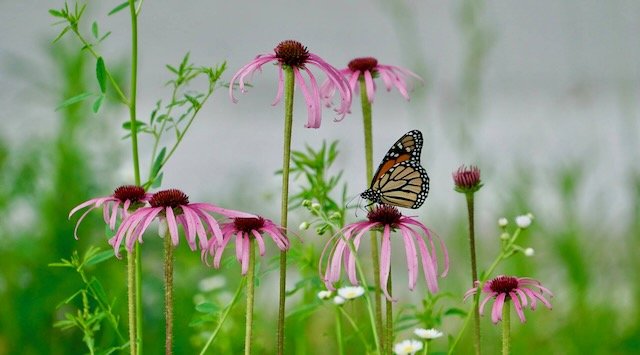A Naturalist Voice
Field notes by J. Cantrell, photos by Patrick Tuttle
Using binoculars should be easy, after all they display no control panels, buttons or a digital screen. Yet, scores of people have trouble viewing objects with a pair of optics. My best advice is simple – keep your eye on the bird. It is straightforward instruction to keep your eye on the object and it works every time. I often observe people in my birding programs or hikes seeing the bird I may point out. They see it and then they take their eyes off the feathered object and look down at their binoculars hanging from around their neck. Soon they have the optics flush to their pupils and they are gyrating their cranium trying to relocate the position they were in just seconds before. If they kept their “eye on the bird” as they bring the binoculars up to their face, they would have the subject magnified and still in view. And no surprise this technique works on watching kids at Neosho’s soccer fields, colorful dragonflies at Carthage’s Kellogg Lake and resting elk in the valleys around Ponca, Arkansas.
October is a wonderful month to pick up a pair of binoculars and give bird watching a try. Naturalists call the hobby “birding” and it is often a combination of nature study, honing observation skills, and sometimes birding has the essence of a scavenger hunt or the Amazing Race television show. I love it and practically grew up birding.
The next step to birding after you have the bird in view is identifying. Field guides with illustrations instead of photographs like the Sibley and Peterson Field Guides are always frontrunners on a birder’s favorite list. There are also several apps that are helpful, plus websites like Ebird(Ebird.org) and Cornell Lab of Ornithology’s All About Birds. The field guides give the observer the opportunity to examine the orders and families of birds and with their inquiry skills they study the field marks and sometimes vocals to determine the species. I recommend the watcher to quietly talk to themselves when they have the bird in focus. By softly describing the bird’s field marks like color, tail shape, wing bars, plumage patterns etc. they are more likely to remember them – so to investigate in the guides’ illustrations later. The biggest error in observations and later with a caller trying to describe an unknown bird to me on the phone is relying on color as the main or the only description. Coloration in birds is incredibly variable and often depends on the lighting the bird’s feathers are receiving and naturally how well the spectator perceives the color hues and tones. The structure of the feathers themselves for example can make a bright blue indigo bunting appear dark like a blackbird.
The hobby of birding quickly leads to learning more about bird life history and the environment as a whole. I know birders who take part for the reason to get outside and hike. Lastly, I’m more familiar with people who enjoy birding for the social friendships and family outings which may be incorporated into the nature walks. A wise nine-year-old once told me “Birding is better with friends”.
There are many extensions of birding and hiking that may integrate self-confidence, citizen science involvement and cross-curricular subjects for youth leaders and educators. Teachers and youth leaders are always welcome to contact me for ideas and classroom activities. And always feel free to drop by the trails at Shoal Creek Conservation Education Center (417-629-3423). The area has an extensive list of birdlife and I’m posting all sightings on E-bird (Newton County, MO) for budding birders and naturalists to see. October will bring fall migrants like white-throated sparrows, and peak numbers of flickers, hummingbirds and buntings. All you must do is keep your eye on the bird! I hope to see you on the trail soon! - Jeff
Jeff Cantrell is a local outdoor/conservation educator covering the SW Corner of Missouri. He may be reached at jeff.cantrell@mdc.mo.gov


